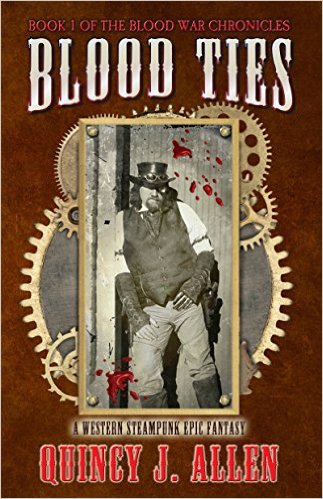For the first few pages of Quincy J. Allen’s Blood Ties , you might think you were reading a straight Civil War novel. Captain Jake Lasater has been commanded to make what may or may not be a suicidal charge on a rebel-held hill, and after making the necessary protests, will do as he’s been told. A sly reference to a Zeppelin may or may not tip the reader off to what’s coming, but when Jake gets to the top of the hill he finds a machine-gun wielding armored monstrosity that never saw action in the real Civil War, and we know we’re in a steampunk novel.
, you might think you were reading a straight Civil War novel. Captain Jake Lasater has been commanded to make what may or may not be a suicidal charge on a rebel-held hill, and after making the necessary protests, will do as he’s been told. A sly reference to a Zeppelin may or may not tip the reader off to what’s coming, but when Jake gets to the top of the hill he finds a machine-gun wielding armored monstrosity that never saw action in the real Civil War, and we know we’re in a steampunk novel.
And then Jake dies.
Only he doesn’t, quite, because in this steampunked version of the Civil War, for just the person at just the right moment, there are other options. So Jake Lasater undergoes some dramatic reconstruction and emerges as a clockwork gunslinger.
Left eye enhanced by a strap-on ocular, left arm and both legs entirely clockwork, Jake is a cool-headed card player and a hard-punching man of violence in the grand tradition of Westerns. His also spiritually sensitive, having apprenticed himself to a Cherokee shaman as a young man rather than waste his time sitting around in his dad’s brewery. And Jake is no loner — his sidekicks include a fellow gunman and a young mechanically-gifted ward. Jake will need every advantage he’s got, when the Tongs of San Francisco start sending supernatural assassins after him to avenge the death of one of their own.
This is steampunk in the best traditions of the genre: freewheeling, fantastic, and adventurous, eager to plunder motifs and themes from any other type of tale, throw them all in a bag, shake them up, see what comes out and punch it between the eyes.

 Follow
Follow





































